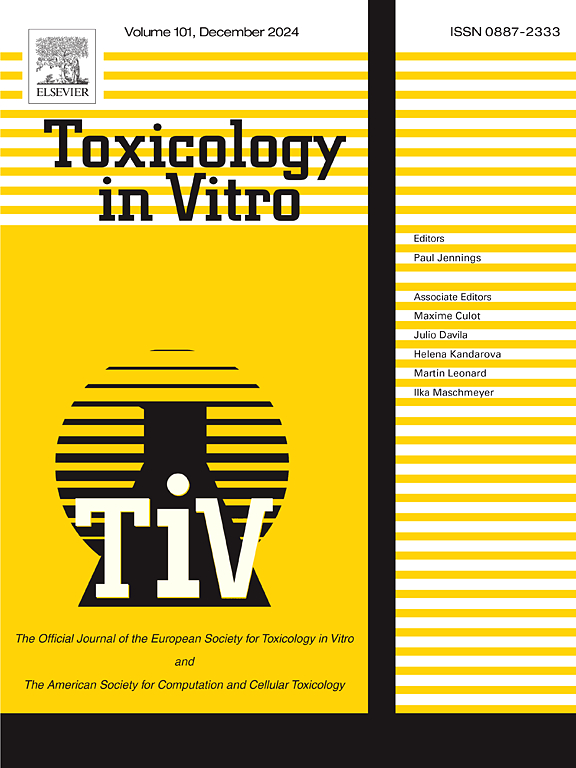An interdisciplinary approach to assessing the toxicity reduction of cerium oxide nanoparticles coated with polyethylene glycol and polyvinylpyrrolidone polymers: An in vitro study
IF 2.6
3区 医学
Q3 TOXICOLOGY
引用次数: 0
Abstract
Objective
This study combines toxicology, analytical chemistry, and nanotechnology to develop cerium oxide nanoparticles, both uncoated and coated with Polyethylene Glycol and Polyvinylpyrrolidone polymers. The objective is to assess their toxicity reduction using cell-based assays.
Methods
Nanoparticles were synthesized using the co-precipitation technique. Scanning electron microscopy (SEM), Fourier-transform infrared spectroscopy (FTIR), and dynamic light scattering (DLS) were employed to characterize their properties. The MTT assay evaluated cell viability, whereas reactive oxygen species and LPO assays were used to quantify oxidative stress.
Findings
The chemical analysis of nanoparticles of the study revealed that cerium oxide nanoparticles exhibited better and more regular morphological characteristics compared to nanoparticles coated with PEG and PVP polymers in terms of size. In addition, cerium oxide nanoparticles combined with PVP polymer did not retain the morphology at the nano level. Toxicological studies demonstrated a reduction in the toxicity of cerium oxide nanoparticles when coated with PEG and PVP polymers.
Discussion and conclusion
The study found that PEG coating significantly reduces the cytotoxicity of cerium oxide nanoparticles more effectively than PVP coating by mitigating oxidative stress. This approach presents a promising strategy for developing safer cerium oxide-based products for pharmaceutical and medical applications.

一种跨学科的方法来评估用聚乙二醇和聚乙烯吡咯烷酮聚合物包覆的氧化铈纳米颗粒的毒性降低:一项体外研究。
目的:本研究将毒理学、分析化学和纳米技术相结合,制备未包被和包被聚乙二醇和聚乙烯吡咯烷酮聚合物的氧化铈纳米颗粒。目的是使用基于细胞的测定来评估它们的毒性降低。方法:采用共沉淀法合成纳米颗粒。采用扫描电镜(SEM)、傅里叶变换红外光谱(FTIR)和动态光散射(DLS)对其性能进行表征。MTT测定评估细胞活力,而活性氧和LPO测定用于量化氧化应激。研究结果:纳米颗粒的化学分析表明,氧化铈纳米颗粒在尺寸上比PEG和PVP聚合物包覆的纳米颗粒表现出更好和更规则的形态特征。此外,与PVP聚合物结合的氧化铈纳米颗粒在纳米水平上没有保持形态。毒理学研究表明,当用聚乙二醇和PVP聚合物涂覆时,氧化铈纳米颗粒的毒性降低。讨论与结论:研究发现PEG涂层比PVP涂层更有效地通过减轻氧化应激来降低氧化铈纳米颗粒的细胞毒性。这种方法为开发用于制药和医疗应用的更安全的氧化铈基产品提供了一种有前途的策略。
本文章由计算机程序翻译,如有差异,请以英文原文为准。
求助全文
约1分钟内获得全文
求助全文
来源期刊

Toxicology in Vitro
医学-毒理学
CiteScore
6.50
自引率
3.10%
发文量
181
审稿时长
65 days
期刊介绍:
Toxicology in Vitro publishes original research papers and reviews on the application and use of in vitro systems for assessing or predicting the toxic effects of chemicals and elucidating their mechanisms of action. These in vitro techniques include utilizing cell or tissue cultures, isolated cells, tissue slices, subcellular fractions, transgenic cell cultures, and cells from transgenic organisms, as well as in silico modelling. The Journal will focus on investigations that involve the development and validation of new in vitro methods, e.g. for prediction of toxic effects based on traditional and in silico modelling; on the use of methods in high-throughput toxicology and pharmacology; elucidation of mechanisms of toxic action; the application of genomics, transcriptomics and proteomics in toxicology, as well as on comparative studies that characterise the relationship between in vitro and in vivo findings. The Journal strongly encourages the submission of manuscripts that focus on the development of in vitro methods, their practical applications and regulatory use (e.g. in the areas of food components cosmetics, pharmaceuticals, pesticides, and industrial chemicals). Toxicology in Vitro discourages papers that record reporting on toxicological effects from materials, such as plant extracts or herbal medicines, that have not been chemically characterized.
 求助内容:
求助内容: 应助结果提醒方式:
应助结果提醒方式:


